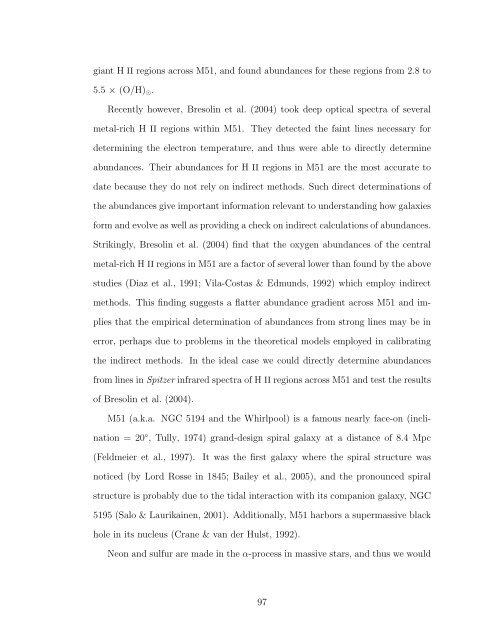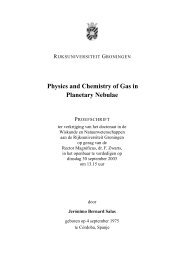TRACING ABUNDANCES IN GALAXIES WITH THE SPITZER ...
TRACING ABUNDANCES IN GALAXIES WITH THE SPITZER ...
TRACING ABUNDANCES IN GALAXIES WITH THE SPITZER ...
Create successful ePaper yourself
Turn your PDF publications into a flip-book with our unique Google optimized e-Paper software.
giant H II regions across M51, and found abundances for these regions from 2.8 to<br />
5.5 × (O/H)⊙.<br />
Recently however, Bresolin et al. (2004) took deep optical spectra of several<br />
metal-rich H II regions within M51. They detected the faint lines necessary for<br />
determining the electron temperature, and thus were able to directly determine<br />
abundances. Their abundances for H II regions in M51 are the most accurate to<br />
date because they do not rely on indirect methods. Such direct determinations of<br />
the abundances give important information relevant to understanding how galaxies<br />
form and evolve as well as providing a check on indirect calculations of abundances.<br />
Strikingly, Bresolin et al. (2004) find that the oxygen abundances of the central<br />
metal-rich H II regions in M51 are a factor of several lower than found by the above<br />
studies (Diaz et al., 1991; Vila-Costas & Edmunds, 1992) which employ indirect<br />
methods. This finding suggests a flatter abundance gradient across M51 and im-<br />
plies that the empirical determination of abundances from strong lines may be in<br />
error, perhaps due to problems in the theoretical models employed in calibrating<br />
the indirect methods. In the ideal case we could directly determine abundances<br />
from lines in Spitzer infrared spectra of H II regions across M51 and test the results<br />
of Bresolin et al. (2004).<br />
M51 (a.k.a. NGC 5194 and the Whirlpool) is a famous nearly face-on (incli-<br />
nation = 20 ◦ , Tully, 1974) grand-design spiral galaxy at a distance of 8.4 Mpc<br />
(Feldmeier et al., 1997). It was the first galaxy where the spiral structure was<br />
noticed (by Lord Rosse in 1845; Bailey et al., 2005), and the pronounced spiral<br />
structure is probably due to the tidal interaction with its companion galaxy, NGC<br />
5195 (Salo & Laurikainen, 2001). Additionally, M51 harbors a supermassive black<br />
hole in its nucleus (Crane & van der Hulst, 1992).<br />
Neon and sulfur are made in the α-process in massive stars, and thus we would<br />
97













